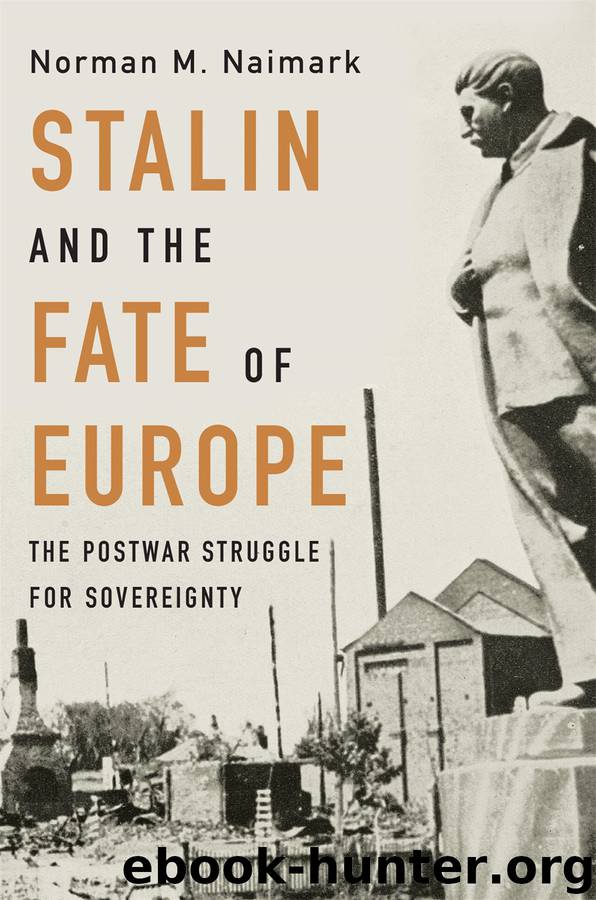Stalin and the Fate of Europe by Norman M. Naimark

Author:Norman M. Naimark
Language: eng
Format: epub
Publisher: Harvard University Press
While Clay and his supporters worked the corridors of power in Washington, trying to convince the waverers in the administration that Berlin was strategically crucial to the American position in Europe, and with Reuter using his formidable rhetorical and political skills to commit the people of the western sectors of Berlin to resist Soviet offers of food and succor in the blockaded city, a critical alliance was forged between the leader of the American occupation, who was known to have little truck with Germans as a consequence of the war, and a German Social Democrat (and a communist in the Soviet Union in the early 1920s), who was skeptical of American-style democracy but committed to efficient, freely elected, and effective municipal institutions.114 Clay’s success depended on Reuter and the Germans; Reuter’s on Clay and the Americans. In this relationship, Reuter was anything but a puppet of the Americans who merely fulfilled their wishes. He answered such taunts, which emanated from some West German circles, communist and others, himself: “The situation is the reverse, the Americans are the voice of Berlin, because we did not carry out American policy but we caused the Americans to carry out Berlin policy and not to leave Berlin to its fate.”115 Among Germans in the western sectors, meanwhile, expressions of support for the Western Allies only increased as the situation grew more critical. Although a large majority of Berliners in the western sectors—82 percent—worried about the imminence of war in July 1948, almost all—98 percent—stated that the Western powers did the right thing by staying in Berlin.116
The commanders of the occupying forces on both sides, meanwhile, were not keen on letting the situation escalate even further. Clay was unhappy about the fact that the British had allowed the huge Reuter-led demonstration at the Reichstag. After the event itself, matters had turned ugly when several hundred Germans converged on the Soviet war memorial near the Brandenburg Gate, throwing stones at Soviet soldiers and East German policemen and spilling across into Pariser Platz in the Soviet zone. When youths managed to tear down the Soviet flag from the Brandenburg Gate and began to rip it up and burn parts of it, several guards from the war memorial rushed over and fired shots into the crowd.117 Reports vary about how many were killed, but Colonel Howley noted that four demonstrators were buried in the east the following week.118 Five alleged perpetrators whom the Soviets had seized were promptly tried and convicted to twenty-five years each in prison. General Russkikh, worried about the propaganda consequences, was critical of these “harsh and undifferentiated” sentences.119
Clay felt that he could not publicly condemn the German demonstration, which he thoroughly disliked, without undermining the German will to resist the Soviets. At the same time, he suggested instead that he and General Robertson, commander of the British occupation forces, talk secretly to the German leaders to make sure they would thenceforth prevent such demonstrations, which, he feared, could otherwise become routine and eventually turn into violence against the occupation regime as a whole.
Download
This site does not store any files on its server. We only index and link to content provided by other sites. Please contact the content providers to delete copyright contents if any and email us, we'll remove relevant links or contents immediately.
The Secret History by Donna Tartt(18852)
The Social Justice Warrior Handbook by Lisa De Pasquale(12143)
Thirteen Reasons Why by Jay Asher(8800)
This Is How You Lose Her by Junot Diaz(6796)
Weapons of Math Destruction by Cathy O'Neil(6148)
Zero to One by Peter Thiel(5690)
Beartown by Fredrik Backman(5600)
The Myth of the Strong Leader by Archie Brown(5427)
The Fire Next Time by James Baldwin(5250)
How Democracies Die by Steven Levitsky & Daniel Ziblatt(5129)
Promise Me, Dad by Joe Biden(5088)
Stone's Rules by Roger Stone(5027)
A Higher Loyalty: Truth, Lies, and Leadership by James Comey(4846)
100 Deadly Skills by Clint Emerson(4843)
Rise and Kill First by Ronen Bergman(4705)
Secrecy World by Jake Bernstein(4651)
The David Icke Guide to the Global Conspiracy (and how to end it) by David Icke(4628)
The Farm by Tom Rob Smith(4439)
The Doomsday Machine by Daniel Ellsberg(4419)
